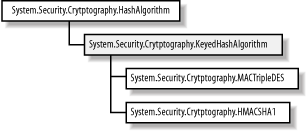| [ Team LiB ] |
|
13.4 Programming Keyed Hashing AlgorithmsThe .NET Framework has a much more direct model for representing keyed hashing algorithms. There are no abstract classes for different algorithms, meaning that there can be only one implementation of each keyed algorithm. Figure 13-7 shows the class hierarchy for keyed hashing algorithms. Figure 13-7. The .NET Framework class hierarchy for keyed hashing algorithms. 13.4.1 The KeyedHashAlgorithm ClassThe KeyedHashAlgorithm class extends HashAlgorithm, adding a new property called Key, which is used to get and set the secret key as a byte array. Aside from this addition, the KeyedHashAlgorithm class provides the same abstraction benefits as using HashAlgorithm for creating normal hash codes. 13.4.2 Instantiating the AlgorithmThe process of creating instances of keyed algorithms is much the same as for normal hashing algorithms. You can create algorithms directly using the implementation class name, or indirectly using the Create method of the KeyedHashingAlgorithm class. When using the direct approach, you can supply the secret key as an argument to the class constructor. In the following fragment, use the System.Text.Encoding class to convert a string into a byte array and to initialize the keyed hashing algorithm: # C#
// define the key as a string
string x_key_string = "This is my secret key";
// convert the string to a byte array
byte[] x_key_bytes
= System.Text.Encoding.Default.GetBytes(x_key_string);
// create the keyed hashing algorithm, using the
// byte array as the constructor argument
KeyedHashAlgorithm x_hash_alg = new HMACSHA1(x_key_bytes);
# Visual Basic .NET
' define the key as a string
Dim x_key_string As String = " This is my secret key "
' convert the string to a byte array
Dim x_key_bytes As Byte( ) _
= System.Text.Encoding.Default.GetBytes(x_key_string)
' create the keyed hashing algorithm, using the
' byte array as the constructor argument
Dim x_hash_alg As KeyedHashAlgorithm = New HMACSHA1(x_key_bytes)
These statements create an instance of the HMAC-SHA-1 implementation class, using the key "This is my secret key." When using the Create method, the key value is set separately, using the Key property. The following fragment demonstrates how to do this: # C#
// create the keyed hashing algorithm, using the
// byte array as the constructor argument
KeyedHashAlgorithm x_hash_alg = KeyedHashAlgorithm.Create("HMACSHA1");
// define the key as a string
string x_key_string = " This is my secret key ";
// convert the string to a byte array
byte[] x_key_bytes
= System.Text.Encoding.Default.GetBytes(x_key_string);
// set the keyed hash algorithm key
x_hash_alg.Key = x_key_bytes;
# Visual Basic .NET
' create the keyed hashing algorithm, using the
' byte array as the constructor argument
Dim x_hash_alg As KeyedHashAlgorithm = KeyedHashAlgorithm.Create("HMACSHA1")
' define the key as a string
Dim x_key_string As String = " This is my secret key "
' convert the string to a byte array
Dim x_key_bytes As Byte( ) _
= System.Text.Encoding.Default.GetBytes(x_key_string)
' set the keyed hash algorithm key
x_hash_alg.Key = x_key_bytes
The Create method creates an algorithm class based on the value of the string argument. Table 13-4 lists the mapping between string values and implementation classes for keyed hashing algorithms.
13.4.3 Hashing Data and Validating Hash CodesBecause the KeyedHashAlgorithm class derives from HashAlgorithm, the processes for creating and validating keyed hash codes is the same as for normal hash codes, with the exception that the value of the key should be set either as a constructor argument or as using the Key property. For reference, Example 13-2 demonstrates how to create a keyed hash code from a byte array of data:
Example 13-2. Creating a keyed hash code from a byte array of data# C#
using System;
using System.Text;
using System.Security.Cryptography;
class ByteArrayHash {
static void Main(string[] args) {
// define the string that we will
// create a hash code for
String x_str = "Programming .NET Security";
// create a byte array from the string
byte[] x_message_data = Encoding.Default.GetBytes(x_str);
// define the secret key as a string
string x_key_string = "This is my secret key";
// create a byte array containing the key
byte[] x_key_bytes = Encoding.Default.GetBytes(x_key_string);
// create an instance of the HMAC-SHA-1 keyed algorithm
KeyedHashAlgorithm x_hash_alg = KeyedHashAlgorithm.Create("HMACSHA1");
// set the secret key for the hashing algorithm
x_hash_alg.Key = x_key_bytes;
// obtain the hash code from the HashAlgorithm by
// using the ComputeHash method
byte[] x_hash_code = x_hash_alg.ComputeHash(x_message_data);
// print out the hash code to the console
foreach (byte x_byte in x_hash_code) {
Console.Write("{0:X2} ", x_byte);
}
}
}
# Visual Basic .NET
Imports System
Imports System.Text
Imports System.Security.Cryptography
Module Module1
Sub Main( )
' define the string that we will
' create a hash code for
Dim x_str As String = "Programming .NET Security"
' create a byte array from the string
Dim x_message_data( ) As Byte = Encoding.Default.GetBytes(x_str)
' define the secret key as a string
Dim x_key_string As String = "This is my secret key"
' create a byte array containing the key
Dim x_key_bytes( ) As Byte = Encoding.Default.GetBytes(x_key_string)
' create an instance of the HMAC-SHA-1 keyed algorithm
Dim x_hash_alg As KeyedHashAlgorithm = _
KeyedHashAlgorithm.Create("HMACSHA1")
' set the secret key for the hashing algorithm
x_hash_alg.Key = x_key_bytes
' obtain the hash code from the HashAlgorithm by
' using the ComputeHash method
Dim x_hash_code( ) As Byte = x_hash_alg.ComputeHash(x_message_data)
' print out the hash code to the console
Dim x_byte As Byte
For Each x_byte In x_hash_code
Console.Write("{0:X2} ", x_byte)
Next
End Sub
End Module
|
| [ Team LiB ] |
|